PRP (The Vampire Facial) Transformed Our Skin On Another Level
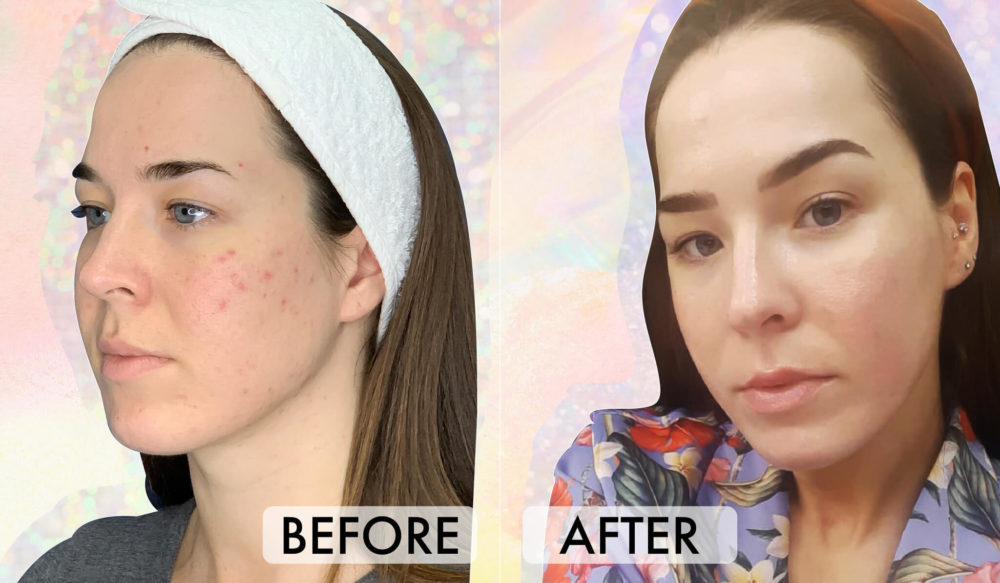
Yes seriously… We tried a PRP Facial – AKA the vampire facial that Kim Kardashian made famous – and literally, the results were more transformative than we could have ever imagined!
View this post on Instagram
(Full disclosure, this is not how most vampire facials end up looking… keep scrolling to watch our treatment, and you’ll see why!)
As someone who has struggled with adult acne and the resulting post-pimple marks, choosing anything other than a full coverage foundation was not really an option that I felt confident pursuing. That is until I tried a Platelet Rich Plasma (PRP) facial, which essentially uses your own blood to regenerate your skin. The results were beyond what I ever imagined, and a year later, my skin is still looking better than I could have ever dreamed. Here’s everything you need to know about the PRP facial that transformed my skin.
What is PRP?
PRP (platelet-rich plasma) is a treatment that uses totally natural substances taken from your own blood to repair and rejuvenate the skin – PRP can also be used to stimulate hair growth when injected into the scalp.
The man behind our dramatic transformation? Dr. Allen Rezai M.D., Founder of Elite Plastic & Cosmetic Surgery Group in Dubai, and leading Consultant Plastic Surgeon in Harley Street London, UK. He explains that the process “Stimulates the body’s own natural healing processes and collagen production, resulting in a fresh, firmer and a more rejuvenated and radiant appearance that is both long-lasting and safe.”
PRP Benefits
From our personal experience, we saw a dramatic change in our skin texture, our post-inflammatory pigmentation literally vanished, and our skin felt and looked plumper and more youthful. Dr. Rezai says that it works best “For those with poor skin tone and texture, fine lines and wrinkles, enlarged pores, sun-damage, pigmentation or scarring due to acne, and surgery or trauma.”
Personally, I was hoping to tackle several things: skin texture, pores, post-inflammatory pigmentation, fine lines, and skin firmness. Spoiler alert, I can check off each of those!
Dr. Sapna Palep, a board-certified dermatologist at Spring Street Dermatology in New York, echoes Dr. Rezai’s sentiment and adds that as well as these benefits for the face, “It can also be done to any part of the body where you’re looking to improve scarring, stretch marks, or skin texture in general.”
PRP, which involves injecting your platelet-rich plasma deep into your dermis (where your skin creates collagen and elastin), can also be combined with mesotherapy. Mesotherapy is a skin-needling treatment – like microneedling but more powerful – used in combination with your extracted PRP to distribute it into the epidermis (the upper layer of your skin). This works so well because it uses your PRP to target both the dermis (with PRP) and the epidermis (with mesotherapy).
PRP & Mesotherapy Before and After:
Here’re a few pics I snapped of my skin before my first ever PRP treatment. You can see I have small active pimples all over my cheeks and along my jawline, coupled with red-looking post-inflammatory pigmentation:
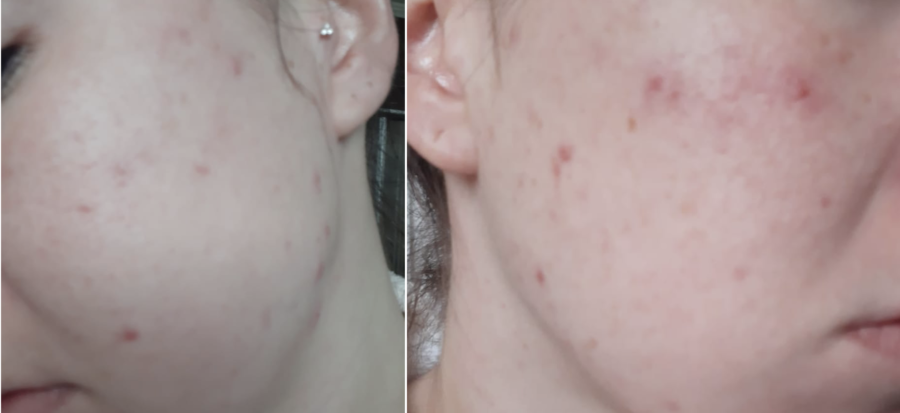 Before PRP & Mesotherapy
Before PRP & Mesotherapy
9 months and three PRP sessions later, I had literally never felt more confident in my skin…
 After 3 sessions of PRP & Mesotherapy
After 3 sessions of PRP & Mesotherapy
Check out the video below to watch the process and see more before and after pics (where you can really see the difference in skin texture)!
How Does PRP Work?
Dr. Rezai explains that the platelet-rich plasma is injected directly into the middle layer of the skin (your dermis) through superficial microinjections into the target tissues. The proteins and growth factors in the PRP improve collagen growth, cell renewal and repair, thereby improving skin texture, elasticity and skin tone. The procedure also causes inflammation in the skin, which also causes the body to react and boost the area with more collagen.
The blood is extracted from your arm and then spun in a centrifuge, which uses force to separate the PRP (platelet-rich plasma) from the rest of your blood. Leaving you with something like this…

The platelet-rich plasma is that yellowy-whitish stuff, which is extracted and injected into your skin and applied topically in combination with mesotherapy.
It’s also recommended to have around three treatments. For the most dramatic results, Dr. Rezai suggests getting the treatments between four to six weeks apart. However, we received three treatments over the course of nine months (thanks, COVID), and we saw insane results!
The PRP Treatment: What to Expect!
Okay, first of all, this is not one of those treatments you just turn up for, walk out of, and go about your day. You should prepare beforehand by avoiding certain things – caffeine, alcohol, anti-inflammatories – at least 3 days before. Post-treatment, well, you won’t be looking cute. You’ll most likely want at least two to three days of recovery before going about your business – but don’t be deterred; the results are beyond worth it!
We had our PRP combined with mesotherapy (this is like a more intense version of microneedling). So, after our PRP injections, a device is used to create tiny holes in your skin’s upper layers before the PRP is topically applied. This treatment combo (PRP and mesotherapy) is extra effective as it helps to target both the top and middle layers of your skin.
PRP & Mesotherapy: The Process
1. Prep: On arrival, numbing cream is applied to your face and neck. Blood is then extracted from your arm, around 6 tubes (per 8ml). The blood is then spun in a centrifuge, and once the blood is separated, the PRP will be drawn into syringes, ready to be injected. We had around 20 to 23 syringes prepared.
2. Extracting & Injecting PRP: Next, the numbing cream is removed, and your skin is cleaned… then the fun begins. The needles will be inserted into your dermis, where the PRP can work its magic at the deeper levels. We had around 15 injections across our cheeks, around our nose, chin, lips, and neck.
Does it hurt? Yes, but it was not unbearable – some injections are fine, but some areas are more sensitive. We very much appreciated Dr. Rezai’s gentle treatment and his mentally preparing us before he did each injection, letting us know which ones might be a little more painful.
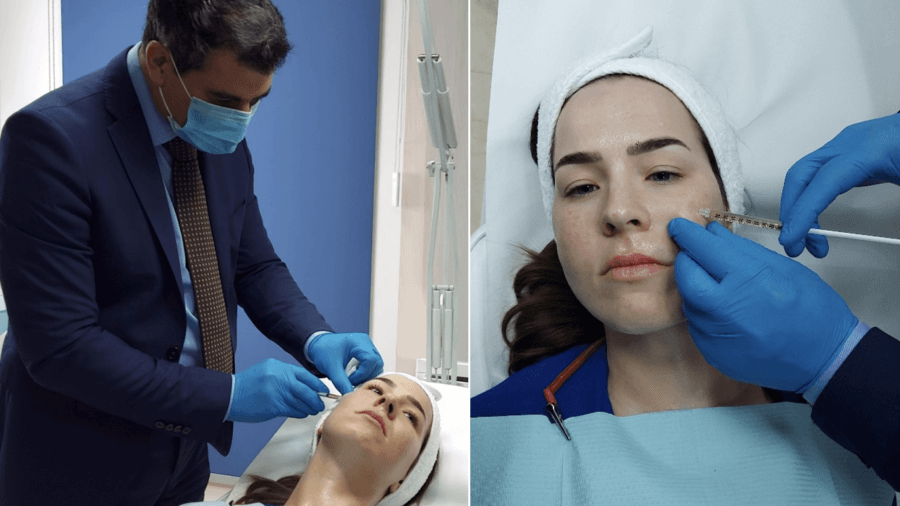 Session 3 of PRP & Mesotherapy
Session 3 of PRP & Mesotherapy
3. Mesotherapy: After the injections, the mesotherapy technique was combined with my final five syringes of plasma. The device pierces the skin repetitively with tiny needles (a bit like microneedling) as it’s pulled across your skin in multiple directions. This process wasn’t painful, although some areas – forehead and nose – were slightly more uncomfortable. During this process, the plasma is simultaneously spread across your skin so it can penetrate the epidermis.
4. Leave-on Plasma: You go home with the plasma still left on your skin. You shouldn’t touch your skin until the next morning, when you can wash off the plasma with a gentle cleanser.
The entire treatment from start to finish took around one hour.
The Downtime: It seems only fair to warn you – we weren’t quite aware of how hilarious we would look post-treatment – all that plasma sitting under your skin means your face looks puffy AF. Add to that the redness caused by mesotherapy paired with plasma, and the result is a bright red face (for the next couple of hours) and major puffiness.
Our tip: Schedule your appointment for late afternoon or early evening. This means that when you leave, you won’t need to worry about applying SPF as you shouldn’t put anything on your skin.
Post-PRP Experience: After washing off the plasma the next morning, your skin will feel tight, and it will still look swollen. It took between 48 to 72 hours for our swelling to fully go down and the redness to subside. During this time, our skin felt itchy, tight and dry, although never painful. Our skin also felt rough-to-the-touch for about four to five days post-treatment.
Posts You'll Love:
PRP Aftercare:
It’s essential that you’re extra gentle with your skin after the treatment. You must avoid any product that might make your skin tingle, which means retinol, any kind of acid – glycolic, lactic, salicylic, kojic – and even vitamin C, are completely off-limits. Instead, reach for your richest, most hydrating and nourishing products. Think ingredients like glycerin, hyaluronic acid, aloe vera, Manuka honey, reparative ceramides, skin-building peptides, and gentle, hydrating oils like jojoba and squalane.
Our go-to post-treatment routine: The Kate Somerville DeliKate range was the perfect post-PRP skincare routine as it’s literally designed to help your skin recover. The formulas – a cleanser, serum, and rich cream – are actually clinically proven to calm irritation, reduce visible redness and help restore a healthy skin barrier.

If in doubt, stick to a very gentle gel cleanser – nothing too drying or intense – and a basic moisturizer. Some other products we love that help protect, soothe and calm the skin post-PRP are the SkinCeuticals Gentle Cleanser, $35, which hydrates and soothes even the most sensitive and dry skin, and the SkinCeuticals Epidermal Repair skin repair cream, $74, which is designed to relieve and soothe the most fragile, compromised or sensitive skin. Our WISHFUL Honey Whip Peptide Moisturizer, $43, is another good option as it’s packed with soothing cica, reparative and nourishing Manuka Honey, and hydrating collagen and hyaluronic acid.
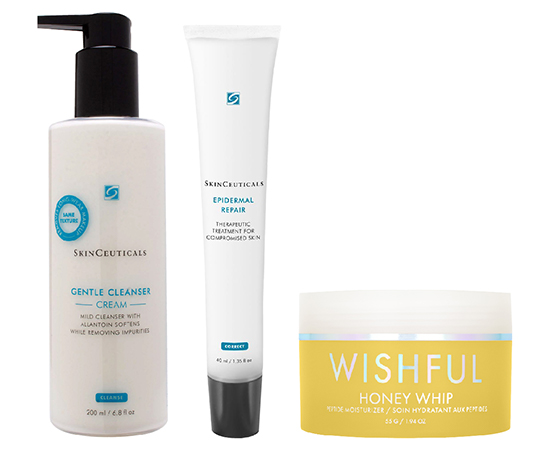 Finally, if you go outside, you absolutely need to wear sunscreen. Opt for a mineral-based sunscreen, as chemical sunscreens could make your skin react at this point. We LOVE the UltraViolet Lean Screen SPF 50+ Mattifying Zinc Skinscreen, $49, which is fragrance-free, doesn’t leave a white cast on the skin and is ideal for sensitive skin. However, we opted to stay indoors during the daytime and avoid SPF altogether for the first four days.
Finally, if you go outside, you absolutely need to wear sunscreen. Opt for a mineral-based sunscreen, as chemical sunscreens could make your skin react at this point. We LOVE the UltraViolet Lean Screen SPF 50+ Mattifying Zinc Skinscreen, $49, which is fragrance-free, doesn’t leave a white cast on the skin and is ideal for sensitive skin. However, we opted to stay indoors during the daytime and avoid SPF altogether for the first four days.
How to Maximize Your PRP Results:
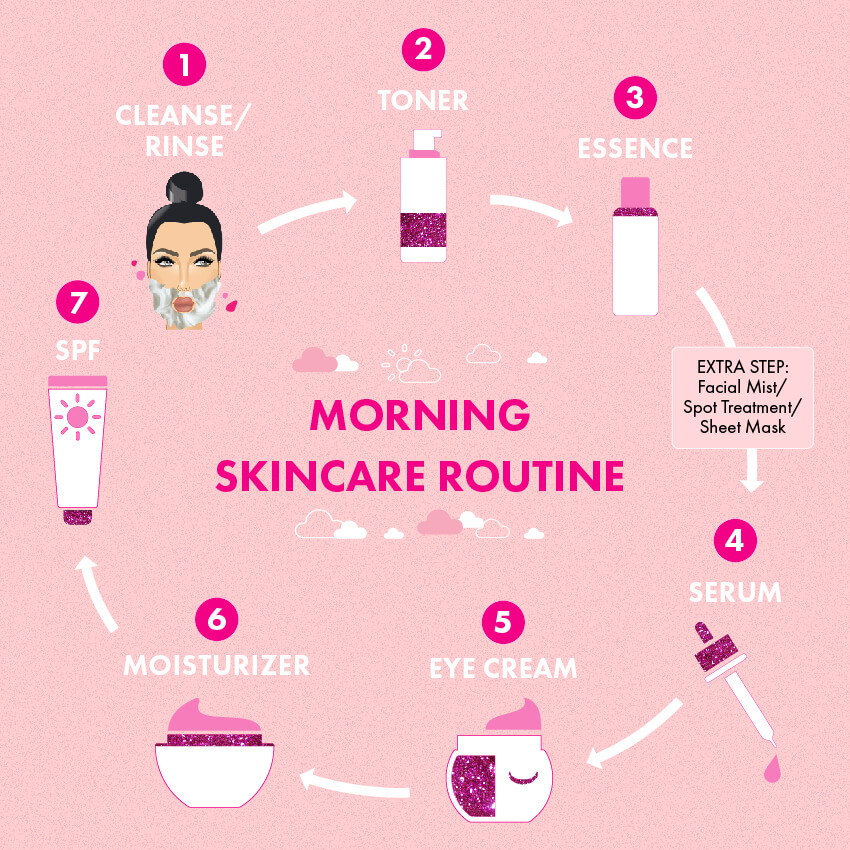
After the initial days when your skin is in recovery mode, maximize your results with an effective skincare routine. Key steps you can slide into your routine include a vitamin C serum every morning before moisturizer and sunscreen, and a gentle retinoid formula in your evening routine. Both of these ingredients are the creme de la creme of the skincare world. Vitamin C brightens and protects the skin and is necessary for producing collagen, while retinol does the most for pores, skin tone and fine lines. Check out our guide to building a good skincare routine here.
Our PRP Review & Experience:
Honestly? This treatment was probably the most game-changing treatment I have ever tried (I’ve tried a lot!). It literally gave me skin that I never thought I could have. Not only did it make my post-inflammatory pigmentation literally disappear, it also improved my smile lines and the fine lines around my eyes. The treatment also gave my skin this incredible plumpness, which became more and more noticeable in the weeks after each treatment. Naturally, our HB fam noticed the difference in my skin, but even my friends who are totally indifferent to skincare were asking me why my skin looked so firm, plump and fresh!
If anything, the before and after pictures are proof of the powers of PRP and mesotherapy. Was this treatment hella expensive? Yes!! Was it worth it – hell, YES! And will we do it again? 100%.
How much does PRP cost?
Average cost: $300 to $800 per treatment*
*For PRP alone. For PRP combined with mesotherapy, costs vary from $600 to $1,500 and up.
Our tips: Go somewhere that you can trust… after we recommended PRP and mesotherapy to our friend, they ended up finding a pretty cheap deal. Unfortunately for our friend, her experience and results were incomparable to ours; she ended up with bruising, less effective results, and was not even briefed about preparation or aftercare before her procedure.
So, choose your practitioner wisely. It is better to spend more to get proper results and have a safe treatment than to save money and get disappointing results, or worse, damaged skin. So do your research and read reviews before you take the plunge. We definitely recommend Dr. Allen Rezai, and we’ll be back to see him in the future!
Got more questions? Let us know in the comments below!




















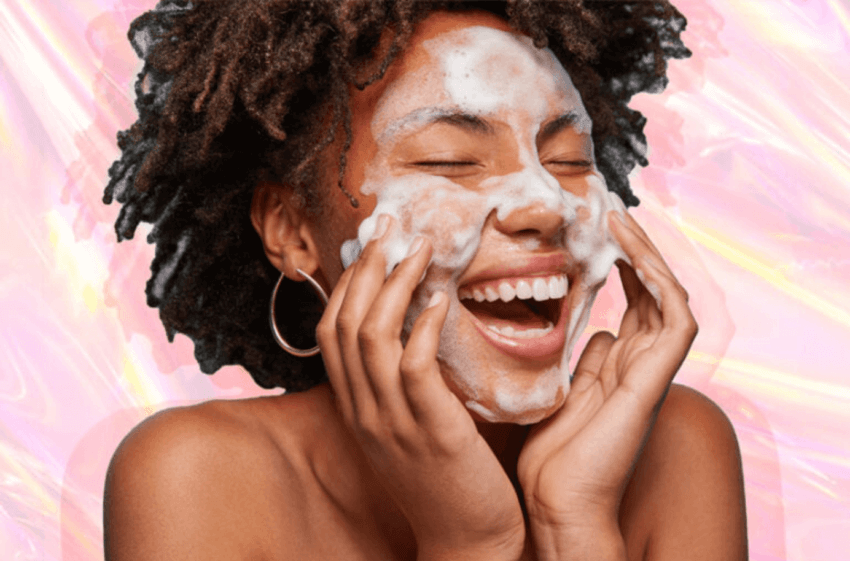


Leave a comment